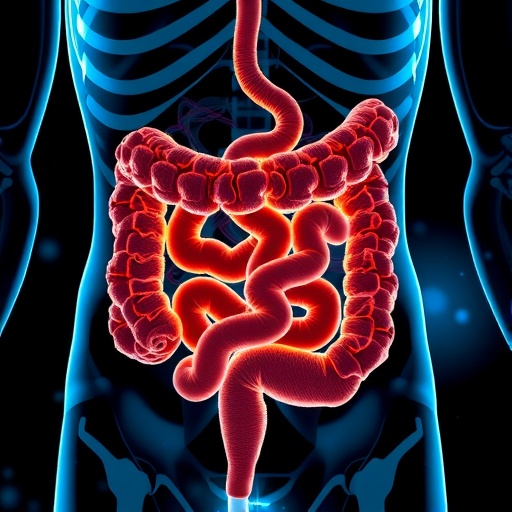In a groundbreaking discovery published in Nature Communications, researchers have unveiled a novel interaction between glucosamine, a common dietary supplement, and the intestinal transporter protein P-glycoprotein (P-gp), shedding new light on how drug absorption can be modulated by seemingly benign compounds. This study uncovers a compelling molecular mechanism by which glucosamine activates P-glycoprotein in the gut, leading to significant inhibition of drug absorption, a finding with profound clinical and pharmacological implications.
P-glycoprotein is a well-characterized ATP-dependent efflux transporter widely expressed in the apical membrane of intestinal epithelial cells. This transporter plays a pivotal role in limiting the oral bioavailability of many drugs by pumping xenobiotics and pharmaceuticals back into the intestinal lumen, thereby reducing systemic exposure. The regulation of P-gp activity is of great interest because it directly affects the therapeutic efficacy of a vast array of medications, including anticancer agents, antivirals, and immunosuppressants.
The current research addresses a critical knowledge gap concerning the interaction between dietary supplements and drug transport mechanisms. While glucosamine is commonly used to alleviate osteoarthritis symptoms, its impact on drug transporters had remained controversial and understudied. The team led by Wu, Wang, and Luo employed a multifaceted approach combining in vitro cellular assays, in vivo pharmacokinetic studies, and advanced molecular simulations to elucidate how glucosamine influences intestinal P-gp function.
The study’s first pivotal finding states that glucosamine acts as an activator of P-glycoprotein rather than a substrate or inhibitor, a surprising revelation given the transporter’s traditional role in defense against exogenous compounds. Through detailed analysis using Caco-2 cell monolayers, a biological model that mimics the human intestinal barrier, the researchers observed increased P-gp ATPase activity upon glucosamine exposure, indicating the transporter’s enhanced efflux capability.
In vivo experiments further cemented these observations. Animal models receiving concomitant glucosamine and P-gp substrate medications exhibited marked decreases in the plasma concentrations of the drugs, confirming that enhanced intestinal P-gp activity results in reduced systemic drug absorption. This phenomenon was shown to be specific and reversible, hinting at a direct regulatory interaction rather than nonspecific drug-binding effects.
Molecular docking and dynamic simulations provided critical mechanistic insights. These computational studies revealed that glucosamine binds to allosteric sites on P-glycoprotein, stabilizing conformational states associated with active drug efflux. This allosteric activation differs fundamentally from competitive inhibition or substrate transport, illustrating a novel modulatory mode for transporters that could extend to other similar ATP-binding cassette proteins.
Importantly, the study underscores the clinical significance of glucosamine’s interaction with P-gp. Given the widespread use of glucosamine supplements by patients, especially the elderly population often on polypharmacy regimens, these findings raise potential concerns about unintended pharmacokinetic interactions that could compromise drug efficacy or toxicity profiles. Physicians and pharmacists may need to reconsider glucosamine counseling in the context of concomitant medication use, especially for drugs with narrow therapeutic windows.
Furthermore, this discovery provides a new paradigm in drug-nutrient interactions. Until now, most supplements were thought to either have minimal impact or only inhibit drug transporters, but this work distinctly positions some nutraceuticals as activators of transporter proteins, opening new avenues for understanding and predicting oral drug bioavailability. It may inspire further investigations into other common dietary components influencing intestinal transport.
Beyond its immediate clinical relevance, the research highlights the adaptability of the human body’s defense systems. The ability of glucosamine to activate P-gp suggests an evolved mechanism where dietary inputs can fine-tune intestinal barrier function, potentially as a protective measure to modulate xenobiotic exposure. This raises intriguing questions about the co-evolution of diet, microbiome, and transporter regulation.
Drug developers and pharmacologists also stand to benefit from these findings. Incorporating P-gp activation assays into early drug development pipelines might better predict drug absorption profiles and drug–supplement interactions. This could lead to optimized formulations or dosing strategies that account for the presence of glucosamine or similar compounds.
The discovery also paves the way for potential therapeutic exploitation. If selective activation of P-glycoprotein can be harnessed, it might serve as a strategy to deliberately reduce systemic exposure of harmful compounds or toxins. Conversely, inhibitors could be co-administered to enhance drug absorption when beneficial.
Notably, the robustness of the findings owes much to the integrative methodology applied. The seamless combination of cellular biology, animal pharmacology, and in silico modeling offers a blueprint for future transporter research. It exemplifies how interdisciplinary approaches are essential for unraveling complex biological phenomena with translational potential.
As the authors discuss, future research should investigate the dose-dependency of glucosamine’s effect on P-gp and how genetic polymorphisms in transporter genes might influence this interaction. Additionally, exploring the impact across diverse populations and different comorbidities will be vital to fully understand the public health implications.
In conclusion, this study revolutionizes our understanding of glucosamine’s role beyond joint health supplementation. It firmly establishes glucosamine as an endogenous modulator of P-glycoprotein activity in the intestine, a function that profoundly influences drug absorption. These insights demand a reassessment of dietary supplement use in clinical pharmacotherapy and may herald a new era in personalized medicine and drug delivery mechanisms.
Subject of Research: Interaction between glucosamine and intestinal P-glycoprotein affecting drug absorption
Article Title: Glucosamine activates intestinal P-glycoprotein inhibiting drug absorption
Article References:
Wu, Q., Wang, Q., Luo, X. et al. Glucosamine activates intestinal P-glycoprotein inhibiting drug absorption. Nat Commun 16, 6100 (2025). https://doi.org/10.1038/s41467-025-61437-2
Image Credits: AI Generated




